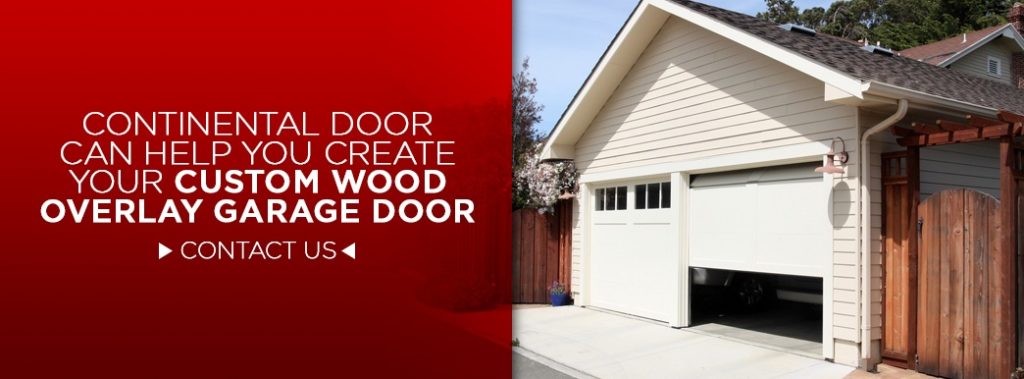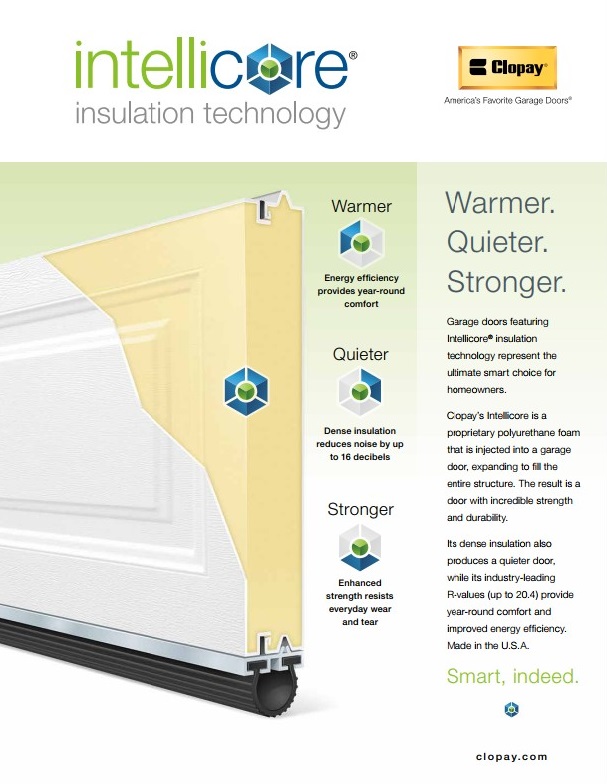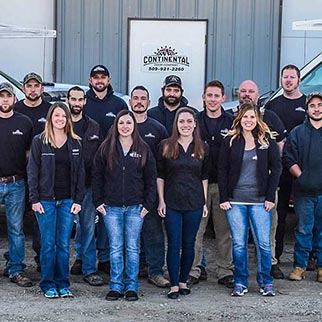The Benefits of a 1.5-Car Garage
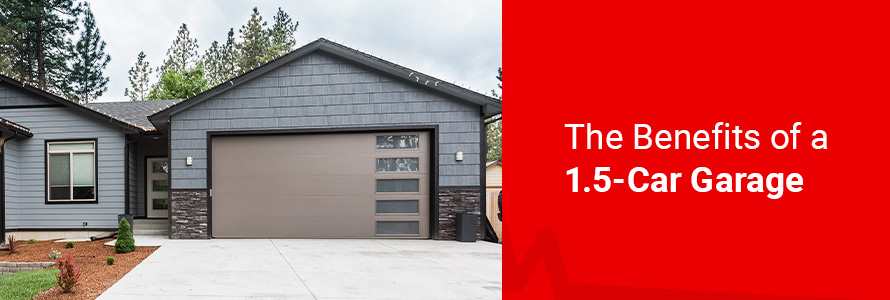
Admittedly, the name is a little bit silly. No one owns half of a car — or at least not one that is drivable! Why, then, is there a designated 1.5-car garage size? Surprisingly, the importance of the 1.5-car garage is growing, especially for homeowners with limited space on their property. Even those who already own a garage are opting to renovate it.
Contact UsIf you find that your garage currently feels cramped or are looking into ways a garage can add to the value of a home, consider whether the 1.5-car garage is the solution for you.
You’ll want to investigate aspects such as 1.5-car garage dimensions, the pros and cons, how exactly to increase your garage size and what goes into installing a new garage door to fit it. This guide provides tips, tricks and information to help you make your decision. Join us as we discuss all things 1.5-car garage!
Table of Contents
- How Big Should My Garage Be?
- What Is The Average Size of a 1.5-Car Garage?
- What are the Benefits of a 1.5-Car Garage?
- How do I Install an Oversized 1.5-Car Garage Door?
- Should I Expand My Garage?
- Are There Any Other Tips for Renovating a 1.5-Car Garage?
- Where Can I Buy One-and-a-Half-Car Garage Doors?
How Big Should My Garage Be?
When looking at statistical trends in new home builds, it is clear that the two-car garage is king. According to a recent study from the National Association of Home Builders (NAHB), 66% of all the new houses that broke ground in 2022 included a two-car garage. An additional 19% featured a garage with enough space for three or more vehicles.
However, not everyone who adds or expands a garage has an open lot available. In such cases, a two- or three-car garage might not be feasible, but a 1.5-car garage may be the perfect solution.

What Is The Average Size of a 1.5-Car Garage?
As the name implies, a 1.5-car garage is slightly bigger than a one-car garage but not quite as big as a two-car option. A standard 1-car or single garage measures between 12 and 16 feet in width, while a standard two-car or double garage usually measures between 20 and 24 feet wide. A standard three-car or triple garage is 30 feet wide.

The dimensions of a standard size 1.5-car garage fall between the single and double garages at 16 to 20 feet wide. Some 1.5-car garages use one-car garage doors, while others capitalize on the extra space and install a larger 1.5-car garage door. Those with larger vehicles often opt for the latter.
All standard garages have roughly the same depth, about 22 feet to 24 feet — although some home designers have chosen special, extra-deep garages. The extra depth is especially useful for boat owners or those who have oversized trucks that could benefit from the additional length. If you are mostly interested in the 1.5-car garage because of the size of the vehicle you are looking to park in your garage, then added depth might be as useful as added width.
In other words, if you are wondering what the best sizes for a garage are, the answer will vary greatly depending on your needs.
What Are the Benefits of a 1.5-Car Garage?
If you have a fleet of vehicles you want to park under a roof every night, the 1.5-car garage may not be for you. However, for those with limited options for expansion, the 1.5-car solution is a perfect fit.
Let’s break down the many benefits of the 1.5-car garage:
1. Small Footprint on Tight Lots
If you live in an urban area, the 1.5-car garage may be the best way to avoid risky street parking. Additionally, if you own an urban or historic home, you know that expansions can be a headache. Houses were not constructed on large yards or acres of property. In such situations, garages may need to be fit into smaller spaces.
However, the standard one-car garage can be limiting. If you want to use a garage for parking a car as well as additional storage, the standard one-car garage just isn’t big enough. On the other hand, the two-car garage may be too big. Especially in historic districts, adding a garage with street access may be difficult, and adding access to two doors may be impossible.

In such situations — where a homeowner wants both versatility and a smaller footprint, the 1.5-car garage is the ultimate compromise.
2. Accommodates Large Vehicles and New Drivers
If you have a new driver under your roof, you know that even the most responsible teenager is liable to scratch a rearview mirror or two. Becoming confident in the width of your rearview mirrors takes years of practice.
However, the risk to the rearview mirrors — as well as the side panels — of your car rises exponentially if your vehicle is wider. If your teen driver is learning on the family minivan, a tight single garage might be even more of a challenge than if you had a sedan.
Many with larger vehicles, such as vans, large SUVs and pickup trucks, opt for a 1.5-car garage with an equally oversized door. While some 1.5-car garages still feature the standard single-size door, the oversized door is a perfect pairing for an equally oversized car.
While this is especially helpful if you have a driver in the household who’s still using their learner’s permit, even if you have years of experience behind the wheel, you could still benefit from some additional side clearance when parking a big vehicle. In fact, if you have a commercial-grade vehicle, the oversized door might be a necessity. Parking in a single-car bay may amount to more than just threading a needle — it may be an impossibility.
3. Provides More Space for Loading and Unloading
For those with very young kids — especially those who still ride in a car seat — the extra clearance on each side of the car will make loading kids in much easier. Leaning into the backseat of a vehicle to latch a kid into their seat is hard enough. Doing so with limited space between the car and a wall makes the process downright back-breaking!
Even if you don’t have little kids, if you regularly transport things — such as groceries, equipment or luggage for travel — in the back seat of your car, having additional space for loading and unloading can make the process much less painful!
4. Gives You Added Storage
While a garage, by its most basic definition, is a place to store vehicles, many of us use that space to store countless other things. In fact, too much non-car storage has become a problem for many homeowners.
According to a 2022 survey, 36% of Americans said their garages are so cluttered that they can no longer fit vehicles inside them.
Unfortunately, the chances of joining this group exponentially increase if you have a single-car garage. That’s because the space is not designed for additional storage in the first place.
However, even if you have a small property and only one car, there are still plenty of things you’d probably love to keep in your garage — garden equipment, snow-clearing tools and sports gear perfectly suit garage storage.
That’s where the 1.5-car garage comes in. The added clearance on both sides of the car and space in the back of the garage can be utilized as storage space. Add in some well-designed storage solutions, and you can ensure you have plenty of space to park both your car and your lawnmower without damaging either.
5. Increases Available Work Space

Whether you are an artist, carpenter, craftsperson, aspiring rock star or a do-it-yourself mechanic, the garage is a great place for your craft. A 1.5-car garage’s expanded size makes the space even more versatile.
If you like to work on your car yourself, you have likely collected several mechanic’s tools over time. These tools take up space. However, considering that they are designed to be used on your car, it doesn’t make much sense to store them in your basement. They are often heavy and can become covered in grease, making transportation laborious and potentially messy. You also don’t want to leave them somewhere insecure, as they can also be expensive. With a single-car garage, both storing your equipment and parking your car is a challenge. A 1.5-car garage gives you the space you need.
If you use your garage as a practice area for an aptly named garage band, you need to make sure you have the space to rock out. While you will likely move your car into the driveway while you practice, a 1.5-car garage allows you to store your equipment between practices.
Regardless of how you use the space, a 1.5-car garage makes that space more versatile.
6. Enhances Accessibility
Guests and household members who use mobility aids benefit greatly from the extra space alongside parked vehicles. Walking frames, wheelchairs and rollators can be more easily maneuvered around the vehicle with a wider perimeter. You may even want to install railings on your garage walls now that you have room.
How Do I Install an Oversized 1.5-Car Garage Door?
While it is easy to see the many benefits of a 1.5-car garage door, the fear of installing one can often deter homeowners from investing. To demystify the process, here’s a short explanation of what is involved in the installation process.

Doors for 1.5-car garages are not a common size. That means many homeowners who want a 1.5-car garage door cannot simply order a standard door and be done with it. For those who are interested in a 1.5-car garage for the added storage but do not necessarily need a larger door, then this isn’t a big deal. In such cases, a standard single-car door may suffice.
However, if your primary motivation for investing in a 1.5-car garage is to accommodate a larger vehicle, an oversized garage with a regularly sized door won’t improve your situation.
In these cases, a custom door is the best solution. That way, you can invest in a garage door that perfectly matches your specifications. Because custom doors are designed to certain specifications, they cannot be mass-produced.
The key to maximizing value without breaking the bank lies in finding a custom garage door manufacturer that is affordable without sacrificing quality. In such cases, you need to partner with a custom fabrication company with a sterling reputation, such as Spokane and Coeur d’Alene’s own Continental Door Company.
A good fabricator will have the tools necessary to make doors to any specification. This includes being well-stocked with common raw spring snakes, meaning they can cut springs — a crucial piece of any garage door — to any length. They will also need the means to customize track assemblies. Finally, welding shops will need to have the means to shape, customize and support heavy steel doors, providing homeowners with beautiful doors that will stand the test of time.
Adding Value to Your Home
As with any home improvement, a garage renovation is about more than added convenience — although that is a huge factor! A garage expansion also has the potential to add incredible value to your home. For those who want to resell their home at some point in the future, added value has the potential of recouping a large portion of the initial investment.
According to Home Advisor powered by Angi, a garage addition will recoup 75% to 85% of its total cost upon selling your house. Regarding return on investment (ROI), that means a new garage ranks above the National Association of Realtors (NAR) ROI 2022 estimation of a complete bathroom renovation (71%) and the addition of a master suite (56%).
As far as increased home values are concerned, a new garage is a safe bet. Other factors — such as the availability of garages in other homes in the neighborhood — could further increase a new garage’s ROI.
However, if you already have a garage and want to improve it — such as expanding the size of the door — then your ROI will actually increase. According to NAR’s 2022 home remodeling research, a new garage door can recoup 100% of its initial cost upon resale. The study also showed that 80% of renovators felt a greater desire to be home after getting their garage door replaced.
Even more promising is JLC’s 2024 Cost vs. Value Report, which placed garage doors as the number one remodeling project for return on investment, reporting a staggering national average of 193.9% cost recuperation. In Spokane, Washington, specifically, the ROI on new garage doors is significantly higher, at 227.5%, meaning you get the entire cost of your new garage door back upon resale, plus over 100% profit.
In addition to ROI, a new garage might make your home more appealing when it goes up for sale. For instance, if you are selling during a time that could be described as a “buyer’s market,” getting a leg up on the competition is a great way to sell a home and avoid costly time spent on the market.
Improving Your Daily Life
Regardless of the dollars and cents of the project, you need to think about how a garage door replacement, addition or expansion will improve your daily life. If you have a hobby that brings you joy but don’t have the space to do it, then the way an expanded garage improves your life will be worth the cost.
If you have a driver in your family who consistently sends you to the paint department at your car dealer, then consider the amount of money a wider door might save you. And if you’re constantly having to bend in awkward positions to get your child into their car seat, then the investment just might be worth it, too.
Are There Any Other Tips for Renovating a 1.5-Car Garage?
If you really want to maximize the ROI of a new 1.5-car garage, there are little things you can do that will go a long way. Here are some of our best tips for maximizing your renovation:
1. Invest in Insulation
If you are renovating an older garage, it likely needs to be better insulated. As homeowners nationwide have become more aware of energy costs and carbon footprints, many new builds have focused on adding insulation. However, even those who add insulation to their older homes often overlook their garages.

Luckily, adding insulation is easy when you are doing a renovation. You will already have your garage empty and installation equipment ready. Basic insulation also isn’t too pricey, so it can likely fit into your budget.
2. Improve Security
Just as older garages tend to lack insulation, they also regularly need enhanced security.
New doors often come with extensive security features and innovative smartphone connectivity options, both of which appeal to most homebuyers. These technological upgrades will also keep your home safer, meaning they are a great investment for you and your family, even if you are not planning on selling anytime in the near future.
3. Look out for Tax Credits
Although our tax system is currently evolving, you should always keep an eye out for home improvement-related tax credits. These are especially prevalent for those looking to improve energy efficiency.
If you can take advantage of tax credits, you can further improve your ROI by recouping investment costs even before it comes time to sell.
Keep in mind that some of these tax credits are specific to your state or locality. So, even if a federal tax credit isn’t available, you may be able to find a state or local credit that can help defray the cost of investing in energy-efficient improvements.

4. Think About Curb Appeal
While we all have our personal tastes, if you are looking to maximize ROI, you need to make sure your improvements are in line with current trends. That way, your home will be more appealing to future buyers.
Luckily, even a new garage door can drastically increase your home’s curb appeal. This relatively inexpensive renovation means you can quickly and drastically increase your chances of selling your home by simply switching out an old, dated door with a new one.
5. Consider Maintenance Costs
When calculating the cost/benefit of a garage renovation, also consider the cost of maintaining an aging door and opener. With so many moving parts that are used repeatedly, day after day, an older door can become more costly to repair than to replace.
So, if your door frequently requires you to reach for the phone and call for a repair, investing in a new door may be a wiser economic move.
These are only a handful of the many things to consider when looking into a garage renovation.

Where Can I Buy One-and-a-Half-Car Garage Doors?
If you are ready to invest in a new garage door, it is imperative that you turn to a partner you can trust. If you are in Spokane, Spokane Valley, Coeur d’Alene or the surrounding area, you can rely on Continental Door Co. for your 1.5-car garage door purchases and services. We’re proud to offer free design consultations for new construction projects and employ an experienced team of well-trained technicians.
Contact UsRely on Continental Door, Co. to Perfect Your New Garage
Since 2000, we have been serving the greater Spokane, Washington, area, providing peerless residential garage door installation, service, maintenance and repair, as well as custom garage door fabrication. We focus on passing on value to our customers, ensuring affordability and prioritizing premium quality.
If it’s time to install your 1.5-car garage door or build your 1.5-car garage addition, contact us online today!

Request Information About Garage Doors
Updated: 09/19/2024
Benefits and Advantages of Wood Garage Doors
Many different garage door materials are available for a brand-new residential garage door. Wood doors offer plenty of advantages to your home, increasing resale value and enhancing its overall curb appeal. Check out the benefits of a wood garage door to determine if it’s the right fit for your property.
Benefits and Advantages of Wood Garage Doors
Wood is a timeless, energy-efficient material that can accommodate any budget. Check out these pros of wood garage doors to learn more about why you should invest in one for your property.
1. Wood Garage Doors Come With Custom Design Options
One of the most appealing features of wooden garage doors is that they come in various styles and colors to complement the outside of your home. Authentic wooden panels have unique graining patterns as special as a human fingerprint. Choose from a wide selection of colors, finishes and panel styles that go with your home’s architectural design.
Wood is also easy to paint or stain if you’d rather have a non-natural color. Consider making your garage door the same color as your entry door to complete your house’s overall aesthetic.
Besides colors, wood garage doors also come in custom sizes and panel shapes to create whatever you need for your home. If you can imagine it, a garage door professional can design it. Wood complements various architectural designs, from traditional to contemporary to modern. Since wood tends to have a timeless design, it’ll always be in style.
2. Wood Garage Doors Are Affordable for Any Budget
Since wooden garage doors offer many customization options, they’re available at different prices. Lightweight doors tend to be less expensive, while sturdier, more durable doors come at a higher price. Either way, you can find a high-quality, affordable garage door made of wood, no matter what you’re looking to spend.
Even if you choose a higher-end wood garage door, you’ll end up saving money in the long run. Wood garage doors of all varieties are durable, and it’s easy to replace one broken panel instead of changing out the entire garage door.
The material itself is also a natural insulator, so it’ll regulate your home’s temperature and save you money on energy use. A wooden door can also save money because it stays in style and can withstand most damage, so you won’t have to replace it as often as other types.
3. Wood Garage Doors Are Resistant to Dents and Easy to Replace
Wooden garage doors are usually resistant to wear and tear, such as dents, scuffs or dings, because of their resistance to impact damage. As long as you maintain your door throughout the years to protect it against moisture and other types of weather, it can look new for a long time and hold up against the elements of your local area.
Besides their resistance to wear and tear, wooden garage doors are also easier to repair. Some garage door materials require a whole door replacement if there’s any sign of damage. On the other hand, an expert technician can fix part of your wood door without investing in a brand-new one.
4. Wood Garage Doors Are Ecologically Friendly
Wooden garage doors are an eco-friendly choice for garage door material. Wood is renewable, naturally occurring material, so having a wooden garage door has a positive impact on the environment. Since wood garage doors last a long time, you can keep the same garage door instead of using more resources to create a new one.
Garage door manufacturers should follow “green” guidelines to ensure that they make the best use of their resources. Discuss your options for eco-friendly wood with your local garage door distributor. You can have peace of mind that your wooden garage door will reduce the size of your carbon footprint.
5. Wood Garage Doors Feature Natural Insulation
Besides being made from an eco-friendly material, wood garage doors are also energy efficient. Even though wood naturally insulates your property, garage door manufacturers also add layers of polyurethane or polystyrene insulation between two wood panels to enhance the door’s energy efficiency. Along with the energy savings that come from investing in an insulated wooden garage door, this material also puts less strain on your HVAC system.
If you’re looking for an energy-efficient door, go over your insulation options with your local garage door distributor. Since your garage door will have extra insulation, your garage and ultimately your entire living space will be more comfortable throughout the whole year. You can also have peace of mind storing temperature-sensitive items in your garage with an insulated garage door.
Choosing Continental Door
Continental Door is a commercial and residential garage door distributor in the Spokane, WA, area. We provide the following Clopay® wooden garage door collections for your selection:
- CLASSIC™ WOOD: Clopay’s CLASSIC WOOD garage doors feature beautiful natural wood, including cedar, hemlock or redwood construction. Each door is handcrafted with flush, traditional raised or recessed panels that complement your home’s architecture and design. Choose a door with a color and style that enhances your property’s curb appeal.
- RESERVE® WOOD CUSTOM series: Our RESERVE WOOD CUSTOM garage doors give you the utmost freedom to create the wooden garage door of your dreams. Sketch a design of your door with the color, windows, size and style you desire, and we’ll make it happen.
- RESERVE® WOOD LIMITED EDITION series: The wooden carriage house garage doors in the LIMITED EDITION series blend the convenience of an automatic overhead door and historical charm. Choose from eight carriage house designs in one of many wood species, colors and window panels to complement your home’s traditional or Craftsman architectural style.
- RESERVE® WOOD MODERN series: Our RESERVE WOOD MODERN garage door series features simple forms and clean lines to accent the wood’s natural beauty. Combine different tones, materials and shapes to design an eye-catching contemporary garage door that complements the wooden decorative elements throughout your home’s exterior.
- RESERVE® WOOD SEMI-CUSTOM series: The wooden garage doors in the RESERVE WOOD SEMI-CUSTOM series feature authentic carriage house styles designed by hand to provide your home with an automatic overhead door with old-world charm. Choose from three wood species, six carriage house designs and several window shapes to complement your home’s exterior.
To try out different styles or to envision how your new garage door will look on your home, use Clopay’s innovative EZDoor™ tool.
Contact Us to Learn More Today
A brand-new wooden garage door adds value to your home because of its warmth, timeless beauty and cost-effectiveness. Continental Door offers many different garage door types for homeowners in the Spokane, WA area. For more information about our inventory or to request an estimate, contact us online or call 509-921-2260.
What Is a Sectional Garage Door? Differences From Single Panel

Your garage door is an integral part of your home. It acts as the main entry and exit point into your house and gives you a safe place to park your car. If you have an attached garage, your garage door even serves as a line of defense against intruders and inclement weather. Garage doors can also increase the value of your home by boosting curb appeal.
Two of the most popular garage door options include sectional and single panel garage doors. Both options have pros and cons, so you should determine which is right for you based on your needs and desires. Learn more about these two types of garage doors so you can make a confident decision.
Table of Contents
- What is a Sectional Garage Door
- What is a Single Panel Garage Door
- Differences Between Sectional and Single Panel Doors
- Are Sectional Doors More Expensive
- Pros and Cons of Sectional Doors
- Pros and Cons of Single Panel Doors
- Should You Install a Sectional or One-Piece Garage Door
What Is a Sectional Garage Door?
Sectional garage doors consist of horizontal panels connected by hinges. This construction allows a garage’s sectional door to bend as it opens and closes by traveling along the roller tracks on both sides of the garage door. These tracks guide the door to rest parallel to the garage’s ceiling when in the open position. Thanks to the hinged panels, a sectional garage door can make it past the curve in the tracks that allow it to open and close.
Sectional garage doors use torsion springs and cables during the opening and closing process. These components make the garage door easier to open and close by hand or with an automatic opener. Sectional garage doors are heavy, and these springs and cables reduce the force needed to operate them.
Many of today’s homeowners choose sectional garage doors for their houses. This popularity makes sectional garage doors a bit more common than single panel garage doors. You can tell a sectional garage door apart from other styles by the slight gaps between the panels. As the door moves past the curve in the tracks, you can see the sections separate by use of the hinges.
What Is a Single Panel Garage Door?
As the name implies, a single panel garage door uses one panel made of metal or wood instead of several hinged sections. People also refer to this style of garage doors as “tilt-up garage doors” due to the way they move when opening them. These garage doors were common in older, midcentury homes, but they are making a comeback in today’s homes thanks to their vintage appeal. Single panel garage doors are also a popular option for old home renovations.
Single panel garage doors have a lower weight which allows them to use simplified opening and closing mechanisms. These mechanisms include a strong hinge system that holds the door by the top of the frame. When in the open position, single panel garage doors slide in an angled, upward motion toward your garage’s ceiling in the space above your vehicle.
Single Panel vs. Sectional Garage Doors: How Do They Differ?
Single panel and sectional garage doors vary in their construction in that sectional garage doors use several panels while single panel garage doors use one. This difference may seem small, but the differences between the two garage door styles only increase from there. The following list reveals many of the other ways these two garage door styles differ:
- Operation: Single panel garage doors remain straight and slide toward the roof of the garage at an upward angle. Sectional garage doors use hinged panels to bend along a track that leads the garage door to rest parallel to the garage’s roof. Thanks to the extension springs of single panel doors and the torsion springs of sectional doors, both styles are easy to open and close by hand. You can also connect both garage door types to an automatic garage door opener for even easier operation.
- Appearance: To the untrained eye, one garage door looks the same as the next. But when it comes to single panel versus sectional garage doors, the visual differences are evident. Single panel garage doors have a unified look capable of showing off elaborate designs, patterns and textures. Sectional garage doors contain small gaps between the panels, and each section has its own design that often matches the other panels.
- Materials: Both styles of garage doors use various types of wood or metal in their construction. These can differ depending on your personal style and your desire to complement the surrounding materials of your home. Generally, sectional doors have thicker and heavier materials, while some tilt-up styles may use lighter options, like aluminum or exterior-grade plywood.
- Security: Security is one of the most important factors to consider when choosing a garage door for your home. Your garage door protects your valuable possessions as well as your loved ones. Sectional garage doors are often the winners when it comes to security, but high-quality single panel garage doors can also offer security benefits.
- Insulation: Most sectional garage doors are well-insulated, while single panel garage doors lack good insulation abilities. A well-insulated sectional garage door can help protect the valuable possessions in your garage while keeping your energy bills lower. If you converted your garage into a climate-controlled living space, you may need a garage door with the best insulating qualities possible. A garage door with lower insulating qualities may suffice for a minimally used detached garage. It all depends on your needs.
- Safety: Consider some safety issues when installing single panel and sectional garage doors. We always recommend hiring a professional to install either type of garage door since high-tension cables and springs require experience to handle safely. Once installed, both garage door types are safe to use and operate, although single panel garage doors use less durable construction.
- Durability: Your garage door should last for years, giving you several benefits to enjoy the whole time. From an increased home value to new conveniences, the durability of your garage door is key. Sectional garage doors use thick, heavy panels, making them the more durable option. Some modern single panel garage doors can also be quite durable, but sectional garage doors are the common winner when it comes to durability.
Are Sectional Garage Doors More Expensive?
You may suspect that sectional garage doors are more expensive than single panel ones. You might think that thicker materials, better insulating qualities, better security and increased durability would all point to a higher price tag. And for the most part, you would be right. Common industry price tags have sectional garage doors at a higher price point than single panel garage doors. Yet the variations in prices differ quite a bit.
Sectional garage doors, while being more expensive, have a wide price range. Prices for sectional garage doors can fall anywhere from several hundred to several thousand dollars. On the other hand, the price of a single panel garage may only run you from a couple hundred to several hundreds of dollars. Your budget may have a lot to do with your decision, so be sure to see how much you can afford before you start your search for a new sectional or single panel garage door.
Pros and Cons of Sectional Garage Doors
Every garage door style has its own list of pros and cons. Here are the pros of sectional garage doors:
- Security: One of the best characteristics of sectional garage doors is their high level of security. The equal distribution of panels makes finding a weak spot difficult for criminals. When a sectional garage door is in the closed position, the panels create a tight seal that is difficult to breach.
- Durability: Another appealing aspect of sectional garage doors is their superior durability. Sectional garage doors consist of thick wood or metal and high-quality hinges to create a durable final product. A sectional garage door can withstand a few accidental bumps with your car.
- Compact operation: The hinged panels of sectional garage doors result in a compact design when opening and closing. The garage door tucks neatly against the ceiling, leaving plenty of room in your garage for your car or stored items. This convenience is especially useful in urban areas or situations with limited space.
With those benefits of sectional garage doors, you should consider the following before making your decision:
- Frequent maintenance: Sectional garage doors contain many moving parts that require frequent maintenance to stay operational. These parts include torsion springs, hinges, rollers, tracks, bolts and other components. Proper lubrication of moving parts is essential, and consistent inspections and preventative maintenance are key to enjoying your sectional garage door for years to come.
- High cost: The high price point of some sectional garage doors is something you should consider. To enjoy the benefits of these garage doors, you’ll have to make sure you have room in your budget. Note that a higher upfront cost could lead to durability and longevity over time.
- Complicated installation and mechanics: DIY homeowners may choose another type of garage door, as sectional garage doors take a professional to install and repair. If you’re considering a sectional garage door for your home, your best bet is to hire a professional for a successful installation.
Pros and Cons of Single Panel Garage Doors
You could enjoy the following benefits of a single panel garage door for your home:
- Variety: Since single panel garage doors consist of one piece of material, you can choose from a wide array of options to complement any house and style.
- Cost: When it comes down to the cost of a garage door, a single panel door wins almost every time. For a more cost-effective option upfront, you may want to look at single panel garage door options for your home.
- Simplicity: Single panel garage doors are simple in their design, construction and operation. You can focus more time on enjoying your new garage door and less on installation, maintenance and repairs.
Here are some factors about single panel garage doors you should consider before making your decision:
- Safety: Single panel garage doors are often thinner and less durable than sectional garage doors. This fact makes them less resistant to brute force and damage from vehicles, the weather and criminals.
- Extensive repairs: Single panel garage doors may be simple to install and operate, but if the door breaks, it can require a complete replacement. You can replace a single damaged panel of a sectional garage door, but if you damage your tilt-up garage door, you may have to replace the whole thing.
- Space limitations: Since single panel garage doors rise toward your garage ceiling at an angle, you could face space limitations. You may need to park your car further from the garage door to make room for this angle. Or you may have to choose a different garage door option if you have a smaller garage.
Should You Install a Sectional or One Piece Garage Door?
You want to make sure you’re making the right decision for your home when choosing a garage door. Consider the following factors to help you analyze your situation and know which option is the best for your needs:
- Space: The amount of space you have in your garage can dictate which style of garage door you choose. If you’re lacking space, you may need to install a sectional garage door. If you have room to spare, you have more options.
- Maintenance: Garage doors get a lot of wear and tear, and they need proper maintenance to keep them working for years to come. Sectional garage doors can be more complex to maintain than single panel garage doors. Factor in your ability to self-maintain your garage door when making your decision. Remember that a professional garage door technician is always available to help you with preventative maintenance.
- Ease of installation: If you like to do your home improvements yourself, you may decide you want a single panel garage door for easier installation. We recommend a professional install any garage door you choose. Keep in mind that your professional installer will need to put in a bit more time for a sectional garage door project.
- Budget: Your budget will be another strong determining factor for which type of garage door you choose. Large budgets can make room for a more expensive sectional garage door. If you need to keep the price of your garage door project to a minimum, you may want to choose a single panel garage door. Keep in mind your long-term budget, as well, when it comes to replacements, repairs and maintenance.
Explore Residential Garage Doors From Continental Door, Co.
Whether you choose a sectional or single panel garage door for your home, you can trust the experts at Continental Door to get the job done. From a new garage door to professional repair services, our offerings make us the company for you in the greater Spokane area. We even offer 24/7 emergency services so your garage door can work when you need it most.
Contact UsEverything You Need to Know About Adding Siding to Your Garage Door

Adding Siding to Your Garage Door
If your garage door needs an update, you can add wood or faux wood siding to your garage door to create a wood overlay garage door. With this technique, you can create a door to complete your home’s sophisticated look.
As you consider how to make your garage door match your home exterior, you can choose a wood design for your garage door to complement your wooden front door. Whether you add siding or buy a custom wood door, you should hire a professional installer to replace or redesign your garage door.
Request ServiceJump to Key Section
- Can You Add Siding to a Garage Door?
- Pros and Cons of Adding Siding to Your Garage Door
- Benefits of Hiring a Professional Installer to Add Siding to Your Garage Door
- Should You Add Siding to Your Garage Door or Purchase a Custom Garage Door?
Can You Add Siding to a Garage Door?
By adding wood siding to a garage door, you can create a wood overlay garage door. Overlaying your garage door with wood can give your garage door more depth to complement and match the rest of your home. Wood siding will adhere to your vinyl garage door with a special type of wood glue.
Pros and Cons of Adding Siding to Your Garage Door
Adding siding to your garage door can give your home a classic look while keeping up with the modern trend. While you can add a wood finish or stain your garage door to give it a wooden appearance, adding siding to your garage door comes with unique benefits:
- Siding offers extra protection: Adding that extra layer could provide even more insulation and protection from the heat and outside damage.
- You can easily customize your garage door to keep up with trends: By adding siding to your garage door, you can create your garage door without having to replace your old one. As the trends change, you can remove your garage door siding and replace it with new siding.
- You can complement the exterior of your home: Home designers suggest coordinating your garage door color and material with your front door. You can complete the sophisticated theme of your home by adding wood or faux wood to your garage door.
There are also drawbacks to adding siding to your garage door:
- Wood can be too bulky: Adding wood or faux wood to your existing garage door could weigh it down, making it difficult to open and close. If your garage door is not designed to handle the extra weight, your siding could damage it.
- Garage doors made of different materials are harder to clean: Wood garage doors are easy to maintain when you have the right equipment and information. If you place wood over a steel garage door, you’ll have to take care of both the wood and the steel pieces.
- Adding siding to your garage door can be complicated: In many cases, purchasing a custom made door instead of adding siding to an existing door will be easier. If you decide to add siding to your garage door, it’s best that you contact a professional garage door installer to handle the task.
Benefits of Hiring a Professional Installer to Add Siding to Your Garage Door
You can install siding on your garage door yourself to create a wood overlay, or you can hire a professional. A professional garage door installer has experience and resources to help you remodel your garage door. Hiring a professional installer to add siding to your garage door may be beneficial to you because:
- A professional installer has experience: If you’ve done home renovation projects on your own in the past, you might be able to create your own siding for your custom door. However, a DIY home project can be frustrating if you are new to exterior design, so you may want to hire a professional who knows what to do. A professional garage door installer typically has years of experience installing and repairing garage doors.
- A professional installer has resources: To create your custom door on your own, you’ll need to buy all the supplies. You also likely need friends or family to help you take on this task of enhancing your home’s curb appeal. A professional will have all the resources and power needed to add siding to your garage door.
- A professional installer has time: While adding siding to your garage door should only take a couple of days, you may have to sacrifice work or a relaxing weekend to put up your siding.
- A professional installer can give you more for your money: A DIY project may save you money if you are experienced. But you will likely pay more money to repair any mistakes you make along the way. A professional installer may cost money, but you know that the professional will do the job right.
As you choose a professional installer to remodel your garage door, you should hire a reputable professional who has years of experience and is highly recommended by previous clients.

Should You Add Siding to Your Garage Door or Purchase a Custom Garage Door?
Instead of adding siding to your existing door, you can purchase a custom garage door. Custom sided garage doors will set your house apart from the rest of the houses on your block. Here are some of the benefits of custom garage doors:
- Extra insulation: In places as cold as Spokane and Northern Idaho, adding insulation to your garage door can also help you lower the cost of your energy bill each month.
- Increased return on investment: Your custom garage door can help enhance your home’s curb appeal and increase your home’s resale value.
- You are in control: When you choose your custom garage door, you can choose the material, finish and design of your door that will complement your home’s design.
If it’s time to renovate your home, consider installing a modern and contemporary garage door. If you would rather have a wood garage door, you can install a door with a wood finish. To prolong the life of your wood garage door, clean it with soapy water and add a stain or finish to it to protect it from extreme weather conditions.
Continental Door Can Help You Create Your Custom Wood Overlay Garage Door
Continental Door has been providing the Spokane and Northern Idaho area with garage door installation and repair services for more than 15 years. We have a wide selection of Clopay® modern garage doors and wooden garage doors to give your home a sophisticated appearance. We can also help you create a custom garage door with or without siding that will complement your home’s exterior.
We are here to answer any questions you may have about customizing your garage door. You can fill out a contact form online or call us at 509.921.2260.
Contact UsUpgrade Your Garage Door, Update Your Home: 7 Reasons Replacing Your Garage Door Is a Great Investment
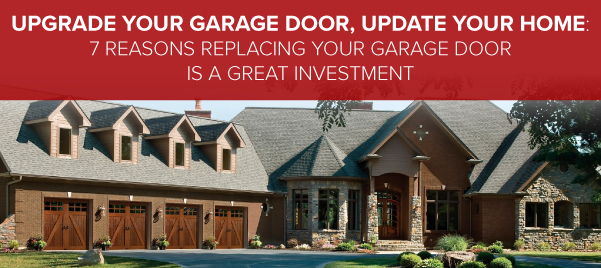
Many homeowners are wondering about simple, affordable and worthwhile investments they can make to upgrade their homes. Some homeowners look for ways to update the look of their home, increase their home value, add new features or improve the functionality and efficiency of their homes. For other families, improving safety and security are paramount.
No matter your reason for making home improvements, you’ve likely considered the best way to get a return on investment. You want to make sure any renovations you commit to are going to be financially feasible, especially if you’re going to be putting out a fairly substantial payment upfront.
There are a few common home improvements experts recommend that earn a great return on investment. Typically, these are kitchen and bathroom upgrades. However, if you aren’t careful, these types of projects can quickly go over budget or take much longer than expected to complete. Other experts recommend investing in landscaping and exterior improvements to enhance curb appeal and improve the resale value of the home.
However, there’s a significant, yet often overlooked home improvement task that’s easy and financially affordable for homeowners — replacing the garage door.
Request ServiceReasons to Replace a Garage Door
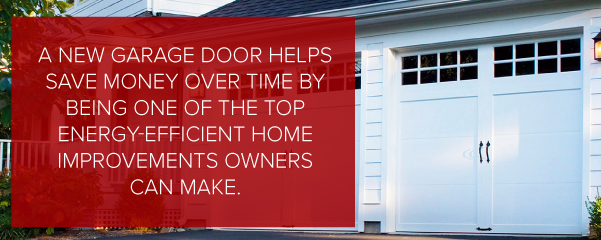
Upgrading your garage door accomplishes many home improvement goals. In addition to being a home improvement project with a great ROI, a new garage door helps save money over time by being one of the top energy-efficient home improvements owners can make. There’s an additional financial incentive to replacing a garage door. Because new garage doors improve energy efficiency, homeowners who upgrade their garage doors may be eligible for various rebates and tax credits at federal, state and local levels as well as through private companies.
For families with young kids or anyone living in urban areas, upgrading your garage door has another all-important benefit — increasing your home’s security. That is one investment outcome you simply can’t put a price on.
There are countless reasons to invest in a home improvement like replacing your garage door. While they seem virtually endless, we’ve narrowed it down to seven key reasons to replace your garage door:
- Improve the curb appeal of your home
- Increase your home’s resale value
- Earn a great return on investment (ROI)
- Reduce your home’s heating and cooling costs
- Lower your maintenance costs on old garage doors
- Improve your home’s security
- Offset your investment through tax credits and rebates
Read on to learn how each of these seven reasons for upgrading your garage door can help improve your home’s curb appeal, value, energy efficiency and home security — and why it’s worth your investment in time and money.
Improve the Curb Appeal of Your Home
Imagination and budget are the only limitations when it comes to opportunities to enhance your home’s curb appeal. Updating your home’s exterior is important, especially in older homes. Not only does it help make the home look better overall, but it also shows that as the owner you care about your property, and you’re taking good care of it.
There are countless ways to update your home’s exterior. You can repaint and reside your home or invest in professional landscaping. These will help update the look of your home, but don’t offer the extensive list of benefits that a garage door upgrade does.
A garage door upgrade is an inexpensive way to update your home’s exterior while producing measurable ROI. You can give your home an entirely new look with a modern garage door that will provide plenty of additional benefits — that’s not something a fresh paint job can claim.
If attached, garages account for a large part of the visual design of the home’s exterior. With an element as substantial as a garage door that takes up one-third of the front view of the home, it’s important to make sure it looks high-quality and adds to the home’s style instead of detracting from it.
In order for your garage door to enhance your home’s curb appeal, you need to:
- Modernize your home’s look
- Remove an unsightly, old garage door
- Install a garage door in a color that complements your home
- Select from endless styles and design ideas that add to your home’s character
- Choose a new garage door material and finish
- Add decorative details like handles and hinges
- Add windows for extra interior light and exterior charm
Re-siding, repainting and landscaping are sizeable undertakings. These types of exterior home improvements may take several days or months to complete. A new garage door installation can be completed in a single day, saving you from the hassle of extensive home renovations that often run over schedule and budget. With a garage door upgrade, you’ll see a substantial improvement in your home’s curb appeal immediately.
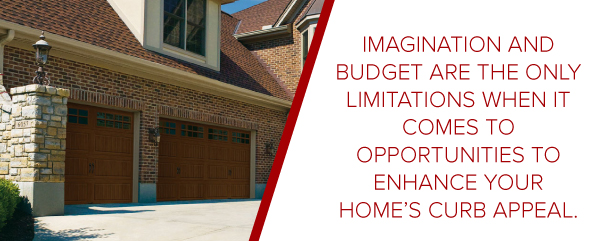
Increase Your Home’s Resale Value
Your home’s value is based on many different factors. Some are factors you can’t control, like your location, the homes in the area and the overall market health. But some of the factors that affect your home’s value are within your control. You can control the upkeep of your home, its overall appearance and the upgrades you invest in.
Replacing an outdated garage door with a new, high-efficiency and modern garage door can instantly add value to your home’s sale price. Garage doors have also shown to retain their value compared to many other conventional household renovations.
In fact, real estate investment experts have established that garage door replacements result in a greater increase in home value compared to some more time-consuming and expensive remodeling projects. One survey showed 70% of homeowners felt a garage door improved the value of their home.
Garage doors are also easier remodeling projects to undertake than other renovations that are proven to increase home value. Professionals can install a new garage door in less than a day in many cases. This frees up your time compared to remodeling projects that require your design input, sign-off and continued communication.
You can’t overlook the fact that a new, modern garage door makes a great first impression when buyers pull up to your house. If you’re looking to increase your home’s resale value and sell your home faster, upgrading your garage door can catch a buyer’s attention and help close the deal quickly.
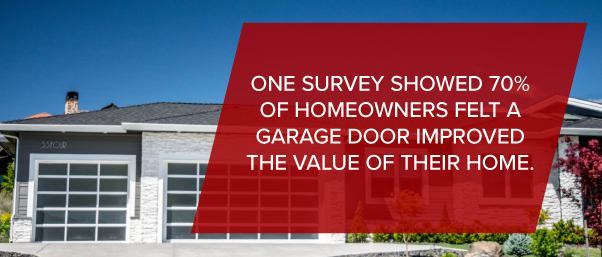
Earn a Great Return on Investment
When considering ways to improve your home’s value, security, curb appeal or energy efficiency, you need to be smart about how you invest your money. A smart investment is one that requires minimal upfront costs, retains its value and works for you in the long-run. Investing in remodels requires homeowners to weigh the costs of the project with the benefits it will produce.
We’ve already seen how a garage door replacement can add value to your home when you go to sell it. But what if you aren’t planning on selling your home anytime soon? Garage doors are still a smart and worthwhile long-term investment.
In addition to helping to add value to your home, garage door upgrades are one of the top home improvement projects with a great return on investment. Here’s why garage door upgrades have a great ROI:
- They retain their value. According to Remodeling Magazine, garage door replacements are one of the smartest upgrades a savvy homeowner can make. The average garage door replacement project retains up to 88.4% of its value. Based on a national average, a garage door replacement job costs $1,595. At resale, the garage is still worth an impressive $1,410. In the Pacific region, a garage door replacement recoups its cost and then some with a value of 110% at resale. The initial job costs an average of $1,756 in the Pacific region and is worth $1,929 at resale.
- They help cut energy costs. If one of your goals is to find ways to reduce heating and cooling expenses at home, then choose a new garage door installation. Many brands of garage doors, including ones from Clopay®, provide energy-efficient solutions. Energy-efficient garage doors prevent heat or cold loss and gain, which cuts back on the unnecessary use of your heating and cooling system. By improving energy efficiency, you can lower your energy costs right away and start earning a return on your garage door investment.
- They provide rebates and credits. In addition to cutting down on monthly bills, garage door upgrades can earn you tax credits and rebates. When you factor this income into the overall costs of the garage door installation, your total investment amount decreases and your payback period shortens.
Looking at the same data from Remodeling Magazine, garage door upgrades are in the top two of remodeling projects that earn a return on investment. Garage replacements beat out bathroom remodels, roof replacements, kitchen updates and siding replacements. The only other remodeling project that had a better return on investment was replacing the entry door with a steel door.
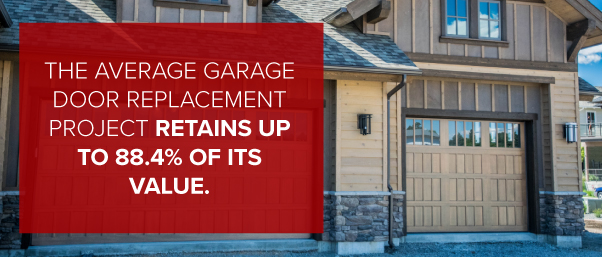
Reduce Heating and Cooling Costs
As a homeowner, you know operating and maintaining your household can be expensive. That’s why many families look for ways to save on their monthly bills. Reducing household expenses requires that homeowners look at opportunities to improve energy efficiency.
One of the best ways cut back on energy costs is to tighten up your home’s building envelope. Ensuring your home is properly sealed prevents expensive heat from escaping during the winter months. It also means that during the colder months, you won’t be air conditioning the outdoors. With proper sealing and insulation, you can prevent heat and cold loss and gain year-round.
Experts are quick to recommend homeowners look at their attached garages as a primary culprit of heat loss and gain. After all, a garage door is the largest opening to your home with the greatest potential to allow hot or cold air to enter. Unless upgraded, most older garages aren’t properly sealed or insulated. By insulating your garage walls and installing an energy-efficient garage door, you can save on energy bills.
Energy-efficient garage doors help with climate control. Garage doors achieve this based on the type of insulation they’re constructed with. The thickness and density of the insulating material also contribute to a garage door’s ability to prevent heat flow. The more heat-resistant an insulating material is, the higher its “R-value”. Well-insulated garages are important in colder climates, especially if you use your garage as a work space or studio. Not only does climate control make your workplace more enjoyable, but it also protects your contents from possible damage due to heat and cold.
Another way garage doors help with climate control is by preventing air leaks. Energy-efficient garage doors mitigate the potential for air to pass through the space between the door itself and the garage’s door frame. This is done through skillful engineering that ensures the strong perimeter lasts. If your garage door has windows, it’s important to ensure they’re energy-efficient, have proper weatherproofing and don’t allow for air leaks.
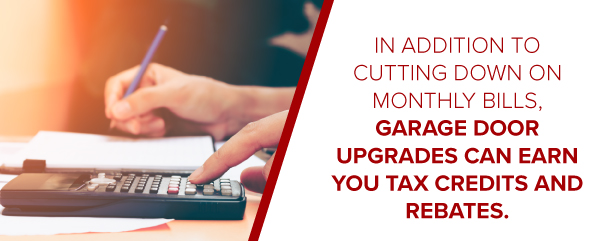
Lower Your Maintenance and Repair Costs on Old Garage Doors
When you own an older home, you can expect to set aside a portion of your budget for maintenance and repair costs. Plus, there’s the added cost in the time required to regularly examine different elements of your home for wear and tear or any glaring issues. Old garage doors typically fall into this category. Because they’re mechanical products, the older they get, the more they wear out — especially if they weren’t properly maintained by previous owners.
A garage door opens and closes an average of 1500 times per year. With that level of use, it’s no wonder garage doors in older homes start to show their age. Garage doors may start to malfunction or just stop running as smoothly as they once did. This requires ongoing inspection and attention to keep them operating properly.
An improperly functioning garage door can even be dangerous. A common issue with older garage doors is that the track isn’t aligned correctly because the rails are bent or there are gaps between the rollers and rails. The weight of the door adds further stress to the track until eventually, it becomes a hazard.
You can try to remedy the problem yourself. Hiring a garage door repair professional is the safer option, but it’s also an added and expensive cost. At that point, you’d have to decide whether it makes more sense to repair or replace your garage door.
Today’s generation of garage doors are engineered to last. A high-quality garage door can last up to 30 years with proper preventative maintenance. By installing a new garage door when your old one wears out, you can cut back on ongoing repair costs and maintenance time, not to mention safety risks. Eco-friendly garage doors have the added benefit of being made from extremely durable materials, which extends the life expectancy of the product.
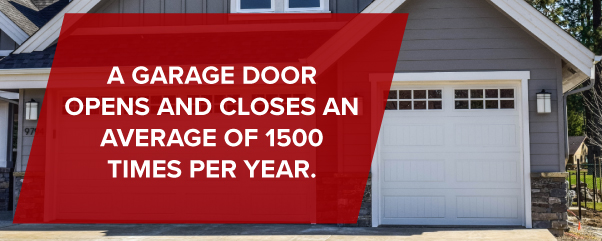
Improve Your Home’s Security
Home technology has come a long way in the past 15 years. With alarm and alert technology, today’s homeowners can always know exactly what’s going on in their homes. This gives homeowners the peace of mind in knowing that while they’re on vacation or at work, their home will be safe.
Everyone has the right to feel safe in their own home. Unfortunately, many older homes lack the same level of security that newer homes have today. Old doors and windows compromise your home, giving experienced burglars easy access points through which to intrude.
One of the ways burglars can gain entry into a home is through the garage. Roughly 9% of people surveyed about break-and-enters in their homes claimed the burglar entered through the garage door. There are a few reasons that make it possible for intruders to breach old garage doors:
- An aging garage door doesn’t lock as firmly. With the right tools, a burglar can easily manipulate an old door lock or pry open the door.
- The motors in old garage doors wear out. This makes it much easier to lift the garage door from the bottom.
- Old garage doors have outdated technology. It’s possible that someone else has a garage door opener with the same frequency as yours. If a thief were to obtain an opener, they could use it to find random homes that matched its frequency.
You won’t have to worry about these security risks with a new garage door. Today’s garage doors are reinforced, lock firmly and can be integrated into a home’s existing security system.
For an added sense of safety, new technology allows homeowners to be in control of their garage doors. How many times have you left the house and wondered whether you left the garage door open? Garage door manufacturers like LiftMaster use smart technology to deliver real-time alerts letting homeowners know when their garage door is open. Smartphone apps also let homeowners control their garage doors remotely.
Your family’s safety is your top priority, and a new garage door can help protect your home so you can sleep better at night.
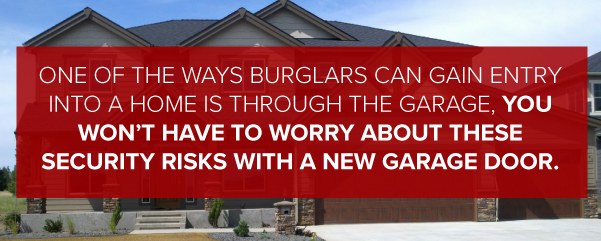
Offset Your Investment Through Tax Credits and Rebates
All homeowners want their upgrades to make sense financially. Fortunately, several incentive programs encourage homeowners to invest in energy-efficiency home improvements. These rebates, tax credits and other incentive programs are available at a local, state and federal levels. Private companies also offer rebates and credits to their customers.
Incentives help make it more affordable for homeowners to choose the best energy-efficient garage door for their home. It also gives homeowners more options because they know they’ll be getting cash back or an income tax deduction. Here are some of the types of incentives available to Idaho and Washington homeowners:

- Federal–Residential Energy Conservation Subsidy Exclusion (Personal): This federal financial incentive is available for homeowners investing in upgrades designed to reduce energy consumption or manage energy demand at home. This program is a 100% subsidy program.
- Idaho–Income Tax Deduction for Energy Efficient Upgrades: Homeowners in Idaho can benefit from a statewide income tax deduction program on energy-efficient home improvements, including adding new building insulation, caulking and weather-stripping, such as through the installation of an energy-efficient garage door. This is a 100% credit on costs of materials and labor on homes constructed before 2002.
Choose Continental Door Company
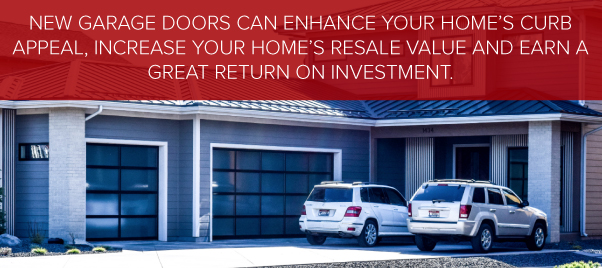
If you’re looking for ways to improve the value of your house, make your home look new or reduce heating and cooling expenses, consider replacing your garage door. New garage doors can enhance your home’s curb appeal, increase your home’s resale value and earn a great return on investment. Your choice of garage doors is endless. With high-tech, energy-efficient garage doors, you can reduce your home’s energy consumption and rest assured the door will remain tightly secured.
Right now, Clopay customers are eligible to win $1000 in the Clopay ImagineNATION Makeover Contest. Submit your before-and-after photos of your Clopay garage door makeover. Visit Clopay to enter the contest before the December 31, 2017, deadline.
Contact Continental Door Company today for more information on replacing or upgrading your garage door. If you’d like to know more about a garage door installation project, reach out to us or stop by our showroom. Our garage door installation experts are looking forward to helping you choose the garage door of your dreams.
Contact us online or by phone at 509-921-2260. You could also visit our showroom Monday through Friday from 7 a.m. to 4 p.m., or make an appointment for a Saturday showing. We’re located at 12718 E. Indiana Ave., Spokane Valley, Wash.
Contact UsWhat Is a Garage Door R-Value?
What Is a Garage Door R-Value?
One thing you may notice when comparing potential garage doors is the door’s R-Value. But what is a garage door’s R-Value — and how important is it when choosing a garage door?
R-Value, Explained
An R-value tells you the level of insulation a garage door provides. Thus, it’s only an issue if you’re seeking an insulated garage door.
There are many benefits to having an insulated garage door. For one, insulated garage doors, since they have that added layer of insulation, tend to be more durable and damage-resistant than non-insulated doors. Naturally, they also have energy-efficiency benefits, keeping heat in during the winter and keeping it out in the summer, reducing your heating and cooling costs.
How Does R-Value Work?
Specifically, R-Value is a measure of thermal resistance to heat flow, or how well the insulation prevents heat from penetrating. This is a factor of the chemical properties of the insulation as well as its thickness. The higher the R-value, the better an insulator your garage door is.
If insulating your garage is important to you, you should seek out garage doors with an R-value of at least 8, which represents a 90% heat flow reduction.
When comparing garage doors and R-values, however, it’s important to note that higher values represent only an incremental increase in heat flow reduction. A door with an R-value of 12 has only 3% greater thermal resistance than one with an R-value of 8. A garage door with an R-value of 16 has only a 2% greater thermal resistance than one with an R-value of 12. Once you go beyond R-value 16, gains are extremely small. A door with an R-value of 32 offers 97% heat flow reduction. A significant number, but only 2% greater than an R-value 16 door.
For this reason, while R-value is important when assessing an insulated door, it should only be one of several factors you weigh to decide whether a particular garage door is right for you.
Order Your Insulated or Non-Insulated Garage Doors From Continental Door Today
If you are looking for a garage door in the Spokane, Washington or Northern Idaho areas, Continental Door is an authorized Clopay® dealer of both non-insulated garage doors and insulated garage doors with R-values as high as 18 or even higher. We can help you choose the ideal door for your home and your family’s needs.
To learn more about the insulated Clopay® garage doors offered by Continental Door, please take a look at the following resource.
To learn more about the many quality garage doors we have to offer, give us a call at 509-792-3098, stop by our showroom at 12718 East Indiana Avenue, Spokane Valley, Washington, or contact us online today.
An Introduction to Garage Door Sizes
There are a lot of reasons to get a garage. Garages protect your car from the elements while also keeping it safe from thieves. They provide your home with extra storage or room for recreational vehicles. They make it easier to unload groceries after a long day at work. And they increase the value of your home.
No wonder then that the National Association of Home Builders reports that 61.9% of homes built in 2014 included a two-car garage. Another 23.5% were built with a three-car garage or larger, a significant increase over the 19% found in new homes built ten years earlier.

However, if you are looking to either remodel an existing garage or build a brand new garage as an addition to your home, you likely have a few questions. What is a standard garage size? How about garage door width? What is the size of a single car garage? Is there a standard double car garage door size?
Because of the wide variety of garage sizes, answering these questions is an essential first step for any proposed garage addition or remodel. That’s why we put together this introduction to both custom and standard garage door sizes.
Whether you are interested in figuring out standard single car garage door dimensions, commercial garage sizes or how much space you need for a triple car garage, we hope that this guide with take the mystery out of all of your garage size questions. Because in the end, we want you to have the perfect garage door size for your home or business.
Contact UsTable of Contents
- Standard Garage Door Sizes
- Planning Your Garage Door
- Further Thoughts on Vehicle Sizes
- Standard Car Size Estimates
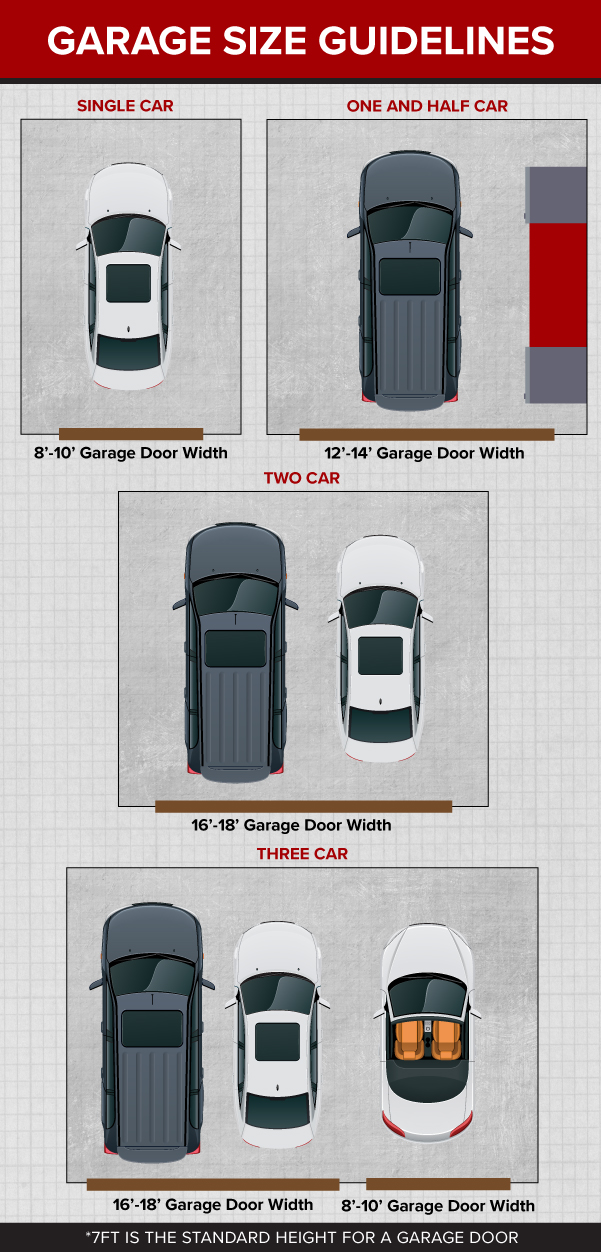
Standard Garage Door Sizes
While the numbers of possible garage door sizes are practically limitless, there are standard dimensions for garage doors that are most common in new garage installations. By incorporating a garage door with a standard size, you can avoid the higher costs of door size customizations. With that in mind, here are the most common garage door sizes.
Single Car and 1.5 Garage Door Size: There isn’t just one standard single car garage door size, there are 3. Doors are either 10 x 7, 9 x 7 or 8 x 7 in size. However, keep in mind that an 8 x 7 size door is a tight fit for SUVs, trucks and vans. If you are looking to build a new addition with typical single-car garage dimensions, you will most likely be incorporating either a 10 x 7 or 9 x 7 size door. The 8 x 7 door size is typically only installed when the dimensions of a preexisting a single-car garage make a larger door impossible.
Furthermore, keep in mind that single-car garage doors make parking an RV or an oversized truck nearly impossible. Similarly, even a 10 x 7 door combined with the size of a single car garage will limit the amount of available storage, especially if you have a full-sized car.
In addition, some homeowners prefer a slightly larger 1.5 car garage to accommodate extra storage or recreational vehicles, especially if they don’t have room for a full two-car garage.
Double Car Garage Door Size: Like single car garage size doors, there are a number of standard size doors classified as doubles. The largest can measure 14 x 7, while 12 x 7 size doors are also available.
While these doors are called double doors since they can accommodate multiple cars, many people with large cars prefer to use a double-sized door even if they only intend to park one car in the garage. The same is true for those who are looking to use half of their garage for parking and the other half for storage.
Triple Car Garage Door Size: A full triple car garage door is rare. Most residential three-car garage door owners instead opt for either one double door and one single or three single doors. That way you can keep the rest of your garage closed when parking one car.
However, if you are committed to having one triple-wide door, there are ways to customize your door to meet your needs. This is an especially good option if you have an especially large-sized vehicle that you want to park in your garage.
RV Size Garage Doors: You may have noticed that while the width of standard size garage doors change, their height remains the same: 7 feet. However, those with extra tall RVs often require more headroom than a 7-foot door can provide.
There are a number of oversized standard doors that are made especially for RV owners. The most common door installed by RV owners is 16 x 8. However, keep in mind that these types of doors usually require further architectural accommodation. You may have a hard time retrofitting an existing garage that doesn’t have the required clearance.
Commercial Size Garage Doors: Finally, commercial-sized garage doors come in a very different standard size. That’s because these doors are designed to accommodate everything from moving equipment to a backed-in semi truck.
The typical size for a commercial-style door is 32 x 24. However, you must also take into account the types of trucks that will be regularly docking at your commercial site. While a typical semi-truck will easily match a 32 x 24 size door, there are a number of more specialized commercial trucks that may require another dimension.
If you anticipate typically accommodating standard-sized trucks, but know that you may occasionally need to receive deliveries from a very different sized truck, you should consider installing multiple doors on your dock, with one door being specially designated for the uncommon sized vehicle.
Planning Your Garage Door
Now that we’ve discussed many of the standard sizes, there are several other things that you should consider if you are planning to build a new garage with a new door installation.
Know What You Need: While a good architect or garage door salesperson would never pressure you into purchasing an ill-fitting garage door, know that most garages use a standard size. Because of this, if you don’t make your needs clear from the onset, you may find that you are dissatisfied with the fit of your car or the storage space within your garage.
The most common requirement is a larger size. Today’s pickup trucks are bigger than ever. Even standard-sized SUVs and full-size luxury cars may be a tight fit in the standard 9 x 7 door.
Furthermore, you want to anticipate reasonable future needs. If you do not yet own an RV, but you think you could very likely own one in the near future, you should consider installing a garage door that can accommodate a taller vehicle. If you install a new standard height door and then realize a year or two later that you also want to add an RV to your fleet, you will likely be stuck parking the RV in the driveway, as raising the height of the door could very well be impossible without tearing down the whole garage.
Think About The Whole Garage: You also don’t want to get caught up thinking only about the size of the door. One of the best features of a garage is its versatility. It is a great place for parking your car but it is also a great place to store things.
Consider this scenario: You only own one car, so you assume that you will only need a single car garage. However, you quickly start to fill your garage with other items, such as sports equipment, lawn mowers and other tools. Before too long, you have to choose whether to keep your stuff where it is or make space for your car.
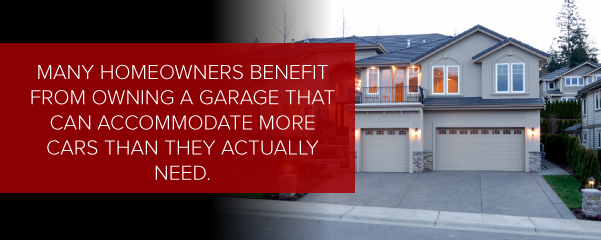
Many homeowners benefit from owning a garage that can accommodate more cars than they actually need. If they are a two car family, they opt for a three car garage. That way, two spots can be used to park cars and the other spot can be used for storage.
This is especially convenient if you plan on storing lawn and gardening equipment in your garage, as most people do. By having a dedicated car port for you gardening equipment, you will find that you can easily access your tools when you need them rather than removing a car just to pull out your mower. Or worse, scratching your car because you are trying to squeeze a weed whacker through a tight spot.
It’s Easier to Make a Door Smaller Than Bigger: Even with the best prior planning, you may find that the size of your door doesn’t match your needs. Reducing the size of your garage door is much easier than expanding it. Structurally, this only requires building in a portion of your garage door opening and then installing the smaller door within the smaller space.
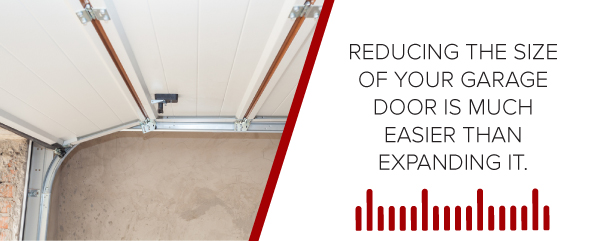
Unfortunately, very few homeowners actually want to have their garage door made smaller. Instead, they come to realize that their small door no longer meets their needs.
The problem is that installing a larger garage door isn’t as simple as cutting a larger hole. Garage doors require at least a foot of clearance above the top of the door. That’s because when the door is opened, it needs space against the garage ceiling to rest or else the inside of your garage will actually be smaller than the opening of the door.
Because of the way garages are designed, they usually aren’t built with space to grow, meaning they only have just as much clearance as is required to fit the original door.
That means if you do want to raise the height of your door, you may need to raise the roofline of your entire garage. If your garage isn’t detached and is built within the main structure of your house, you will likely find raising the roofline to be either impossible or so cost-prohibitive that it isn’t worth the investment.
If your garage is detached, you may find that raising the roofline is worth it, but regardless, it will be far more expensive than getting the taller door installed initially.
Further Thoughts on Vehicle Sizes
While you may agree that planning ahead is good, and making a smart investment is the best path for building your new garage, you may also still be unsure about the best size garage for the specific vehicle you own. To help you get a better sense of how your car may fit in your garage, we thought we would break down exactly how to measure your car and compare that with what other dimensions you’ll need.
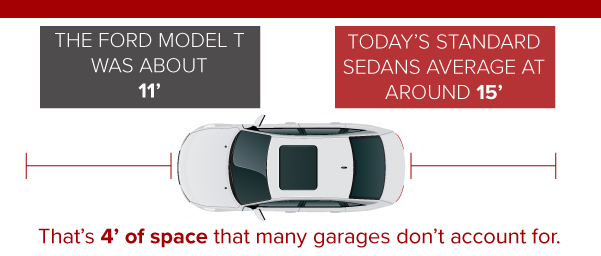
According to Houzz, garage sizes haven’t changed, even as car sizes have. To put this in perspective, they note that the Ford Model T was 134 inches long, about 11 feet. Today’s standard sedans average at around 15 feet. That’s 4 feet of space that many garages don’t account for.
What guidelines should you then use when planning the dimensions of a new garage?
Space Between Cars: Obviously, this only applies to garages that are going to accommodate more than one car. However, keep in mind that with a single car garage, you will have limited space for storage or future growth in your household.
It is recommended that you leave at least 36 inches of space between your cars in order to prevent accidentally denting your other car with your door.
Consider Storage Furniture: If you are planning on using your garage for storage, at least in some capacity, you should also make sure to build storage furniture into your measurements.
Luckily, storage cabinetry for garages is very similar to kitchen cabinetry. Most garage cabinet systems are 24 inches deep, but if you have to work with tighter spaces, you can also find slimmer cabinets that are 12 or 18 inches deep as well.
Consult Your Car Manufacturer: One of the nice things about being a car owner today is that you can skip pulling out a tape measure if you want to know the exact length and width of your car. Just go onto the manufacturer website for your car and pick your exact model and year and you can easily find your vehicle’s specifications, assuming you haven’t made any drastic aftermarket modifications. Don’t forget to include the mirrors in the width measurement!
Once you have the width and length of your car along with the depth of any storage furniture you plan installing while making sure to include the minimum space between cars, you will have the data you need to make an informed garage design decision.
Consult Local Building Codes: While you may have an ideal garage size in mind, you also need to make sure that any future construction is in compliance with local building codes. Historic districts may have a limit on the size of your garage while other zoning codes have specifications on the minimum size allowed.
Don’t Forget the Lawnmower: While some homeowners opt for a storage shed for their lawnmower, many keep theirs in the garage. Depending on the size of lawnmower that you use, you may have a very hard time getting it out of your garage unless you’ve built in an appropriately sized space for it.
This is especially true if you own a riding lawnmower. If you keep your lawnmower against one of the garage walls, getting it out will either require moving your car first or having enough clearance beside your car to move the lawnmower out with the car still parked.
If you are choosing to use one of your available car ports for storage, this is a great place to keep your lawnmower. Even the largest lawnmower designed for home use is much smaller than a car, so you will have plenty of space for storage in front of where you park your mower.
Standard Car Size Estimates
Although you should use the specifications of your car if possible, if you are building a garage that you want to be accommodating for potential future purchases, it may be helpful to have a sense of the average size of cars of various classes.
Vans and SUVs:
These are the largest cars in the typical family fleet. They are usually 6 to 7 feet wide, 16 to 19 feet long and 5 to 6 feet high. Keep this in mind if you are considering the smaller 8 x 7 foot door. A 7 foot wide van will be a very tight fit in one of these smaller entries.
Standard and Luxury Sedans:
While they are not as large as SUVs, these large sedans can still be sizable. Furthermore, while scraping the side of any car is frustrating, scratching a luxury car can be especially costly. These sedans average 6 to 6 1/2 feet wide, 16 to 18 feet long and 4 1/2 to 5 feet high.
Sports and Compact Cars:
At the end of the day, smaller cars are easier to park in a garage of any size. They are usually between 5 to 6 feet wide, 14 to 16 feet long and 4 to 5 feet high.
Local Garage Door Installation and Design Planning
If you are in the Greater Spokane Washington or Northern Idaho areas, there is no better place to turn for garage door repair and installation than Continental Door Company.
We offer a wide selection of residential doors in every standard size, as well as commercial and industrial garage doors. So regardless of your design tastes or proposed configuration, you are sure to find what you need with us. Furthermore, we are experienced with custom door fabrication, meaning that even if you have specific needs that cannot be met with factory standard doors, we can take care of you.
Regardless of what design you choose, whether you are opting for a factory standard door or a custom made one, you can trust in our quality. We know how important our work is for the people of Spokane, whether they are business or homeowners.
Whether you are looking to build a whole new garage or simply want to give your existing garage a facelift, contact us for a free estimate. Even if you are still trying to figure out exactly what your garage plans are, our professional staff are able to assist you with any measurements or planning, helping to make your job easier.
Request An EstimateView Our Guide to Understanding Garage Door Sizes
Transcript:
“Hi, Derek with Continental Door here, and today I’m going to go over door sizes. So you’ve got a one car garage — a single car garage — which is over here, and that’s defined off the width. It can be anywhere from as small as seven, eight, nine, or ten feet. This one over here is a ten wide, that’s a single car, and then a car and a half garage is something that is in between there. It’s not quite a two car, like over here — an eighteen by eight, it’s a twelve or a fourteen or something in between where it’s kind of a car and a half, it’s not quite a one car or a two car. A two car garage is anything greater than sixteen or eighteen [feet] that you can park two cars in. Thank you for watching! For any questions, please feel free to call us or check us out online.”
Request Information About Garage Doors
Updated: 05/22/2019





